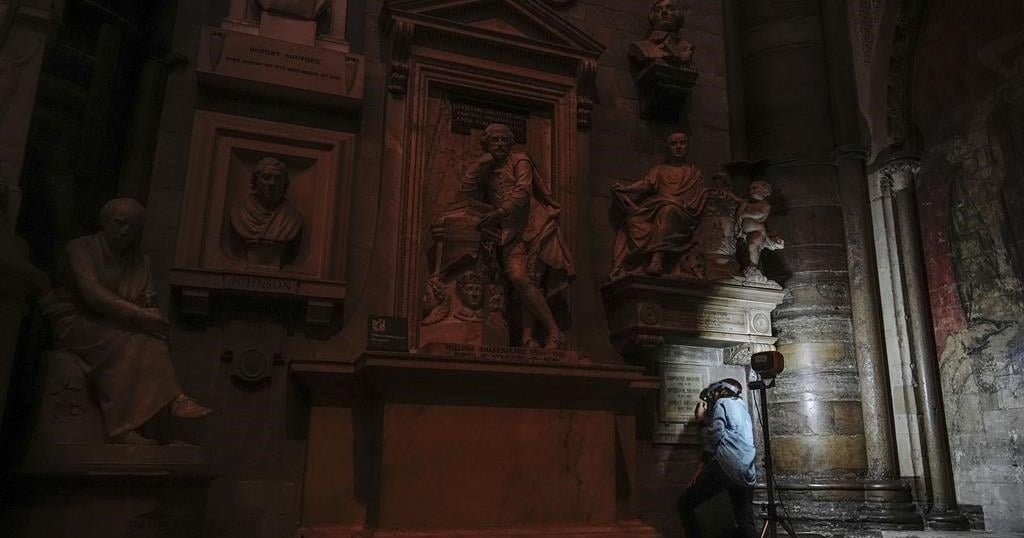On a patch of street where drivers used to pull up in front of a Hyattsville coffee shop to dash inside and grab their orders, bright blue coffee beans are now stenciled over rainbow blocks of color.
Art
Artist Graham Coreil-Allen paints on streets for pedestrian safety

The message, reinforced by planters and plastic flexposts, is clear: This isn’t a space for cars anymore. The artwork spreads up the street and around the corner, where clouds and bands of red, orange and yellow mark out space at crosswalks and stripes beckon buses up to a stop.
The collaboration between officials in Hyattsville and Baltimore-based artist Graham Coreil-Allen is part of a growing movement to use art as a tool to promote pedestrian safety, an appealing option for cities looking for quick and affordable responses to a perplexing nationwide increase in fatalities.
“It helps establish this as a place,” said Coreil-Allen, 41, who seeks to turn streets into somewhere people on foot can enjoy rather than being only for cars to pass quickly through.
The number of people on foot killed by drivers in the United States has surged in recent years, with an estimated 7,500 deaths in 2022 — the highest figure in over 40 years. Plastic posts and swatches of color offer less protection than concrete barriers, and without hard data and clear federal guidance, some transportation engineers have been skeptical about turning to art as a safety measure. But the idea got a boost this month in an overhaul of a widely used design manual for streets, with federal transportation officials stating clearly that their guidelines don’t prohibit what they call “aesthetic surface treatments.”
“This is a win for sure,” Coreil-Allen said.
Federal transportation officials are taking a growing role in trying to protect pedestrians and cyclists. Federal highway officials said in a document explaining the design manual changes that they plan to study how street art could help, pointing to a report sponsored by Bloomberg Philanthropies in 2022 that studied the effect of art installations at 17 locations in cities around the country. The study’s authors concluded that the projects were linked to a 50 percent decline in crashes involving pedestrians.
The update to the design guidelines, known as the Manual on Uniform Traffic Control Devices, is part of that effort and includes updated standards for crosswalks and bike infrastructure. When it was released, Transportation Secretary Pete Buttigieg said the aim was to help cities, counties and states “make it safer to walk, bike, and drive.”
The federal government also has new money to spend on the problem. The infrastructure law provided a $5 billion fund to help local governments design and build safer streets. The most recent round of awards went to 385 projects around the country, including $9.8 million for Mount Rainier, another Prince George’s County city. The project will tackle filling gaps in sidewalks, lowering speed limits and improving intersections.
A full-scale redesign and rebuild of a street with pedestrians and cyclists in mind might take years of planning and a budget in the hundreds of thousands of dollars, but a project like the one in Hyattsville can be finished at a fraction of the cost.
But in the conservative world of traffic engineering, the idea of painting on streets has encountered some resistance. While many cities including the District are experimenting with the idea, the state highway agencies that control the busiest and most dangerous roads have been more hesitant, Coreil-Allen said.
The Maryland Department of Transportation said it would review the new sections on street art in the updated manual in coming weeks.
“The Maryland State Highway Administration strives to ensure a consistent and uniformly marked highway system that conforms to all applicable federal and state guidelines,” the department said in a statement.
Coreil-Allen integrates his work into more established ideas like extending curbs part way into a crosswalk to narrow the space people have to traverse, a technique called a “bump out.” Adding bright areas of color catches drivers’ attention and sends a signal that the street isn’t only somewhere for them to zip through.
“It provides a cue to the motorists to slow down,” Coreil-Allen said. The idea, he said, is to offer an interim solution until a permanent change can be put in place. Coreil-Allen has worked with communities around Baltimore, where he moved to earn a graduate degree at the Maryland Institute College of Art. As a student he installed a DIY crosswalk on a road near the college, posing as a construction worker at night. Then in 2013, the city commissioned an official project.
“It got me excited,” Coreil-Allen said. Within a few years he had launched a company and is now planning on hiring his first full-time employee.
He uses materials common in the road construction industry, working with suppliers able to produce coatings in the bright colors he needs. Stooping over the sidewalk, he can explain in detail about how different materials bind to the surface of a street and the pros and cons of each — a grasp of the technical aspects of his work that he said helps him relate to street maintenance crews.
The Hyattsville project was completed in October, and Taylor Robey, the city’s transportation manager, said so far the response has been positive.
“Asphalt art is exciting because it’s obviously nice to look at, it’s eye-catching, but there’s also been more recent studies showing it improves safety,” Robey said. “It’s a leap of faith sometimes, but in our experience with asphalt art, the community was excited to see something different.”
On a recent morning, Coreil-Allen stopped by to check out how the work was holding up after a few months exposed to traffic. People ambled through the quiet streets, color under their feet.
“You’re immersed in art,” Coreil-Allen said.

Art
40 Random Bits of Trivia About Artists and the Artsy Art That They Articulate – Cracked.com
[unable to retrieve full-text content]
40 Random Bits of Trivia About Artists and the Artsy Art That They Articulate Cracked.com

Source link
Art
John Little, whose paintings showed the raw side of Montreal, dies at 96 – CBC.ca
[unable to retrieve full-text content]
John Little, whose paintings showed the raw side of Montreal, dies at 96 CBC.ca

Source link
Art
A misspelled memorial to the Brontë sisters gets its dots back at last

LONDON (AP) — With a few daubs of a paintbrush, the Brontë sisters have got their dots back.
More than eight decades after it was installed, a memorial to the three 19th-century sibling novelists in London’s Westminster Abbey was amended Thursday to restore the diaereses – the two dots over the e in their surname.
The dots — which indicate that the name is pronounced “brontay” rather than “bront” — were omitted when the stone tablet commemorating Charlotte, Emily and Anne was erected in the abbey’s Poets’ Corner in October 1939, just after the outbreak of World War II.
They were restored after Brontë historian Sharon Wright, editor of the Brontë Society Gazette, raised the issue with Dean of Westminster David Hoyle. The abbey asked its stonemason to tap in the dots and its conservator to paint them.
“There’s no paper record for anyone complaining about this or mentioning this, so I just wanted to put it right, really,” Wright said. “These three Yorkshire women deserve their place here, but they also deserve to have their name spelled correctly.”
It’s believed the writers’ Irish father Patrick changed the spelling of his surname from Brunty or Prunty when he went to university in England.
Raised on the wild Yorkshire moors, all three sisters died before they were 40, leaving enduring novels including Charlotte’s “Jane Eyre,” Emily’s “Wuthering Heights” and Anne’s “The Tenant of Wildfell Hall.”
Rebecca Yorke, director of the Brontë Society, welcomed the restoration.
“As the Brontës and their work are loved and respected all over the world, it’s entirely appropriate that their name is spelled correctly on their memorial,” she said.
The Canadian Press. All rights reserved.
-

 News13 hours ago
News13 hours agoChrystia Freeland says carbon rebate for small businesses will be tax-free
-

 News13 hours ago
News13 hours agoFACT FOCUS: Election officials knock down Starlink vote rigging conspiracy theories
-

 News13 hours ago
News13 hours agoFormer B.C. premier John Horgan, who connected with people, dies at 65
-

 News13 hours ago
News13 hours agoNova Scotia election promise tracker: What has been promised by three main parties?
-

 News13 hours ago
News13 hours agoB.C. teen with bird flu is in critical care, infection source unknown: health officer
-

 News13 hours ago
News13 hours agoSuncor Energy earnings rise to $2.02 billion in third quarter
-

 News13 hours ago
News13 hours agoSwearing-in ceremonies at B.C. legislature mark start of new political season
-

 News13 hours ago
News13 hours agoFederal government launching research institute for AI safety





















